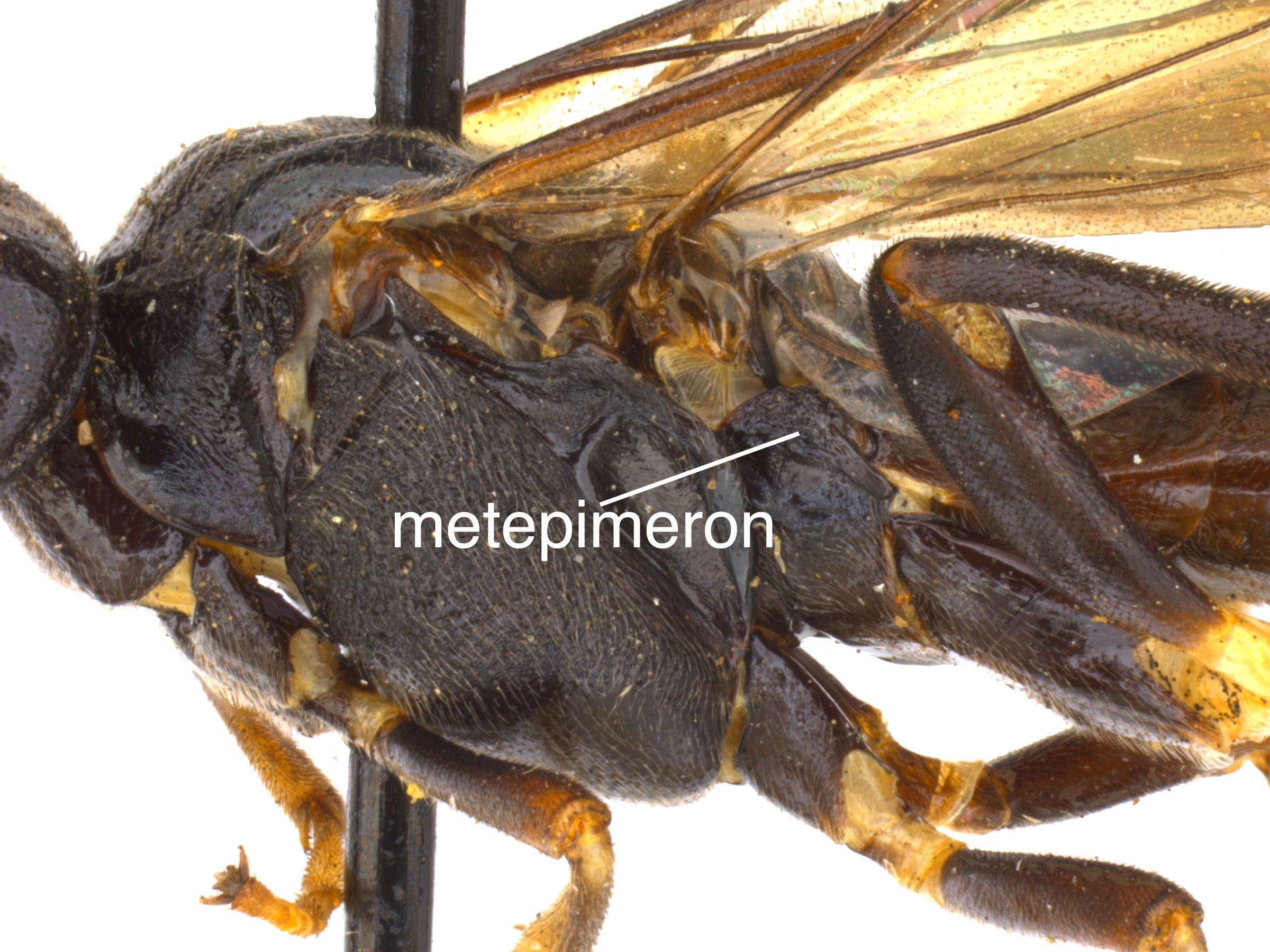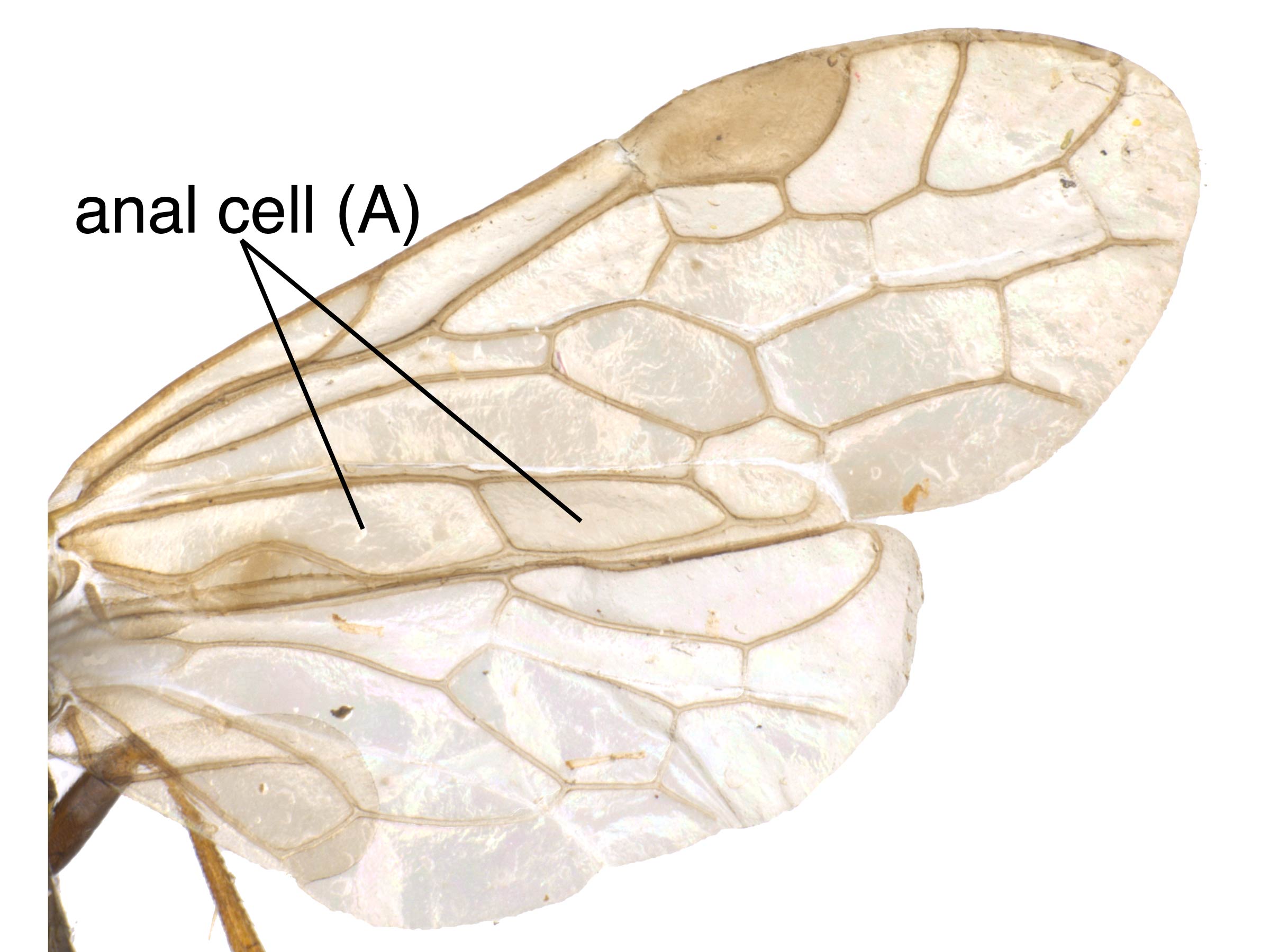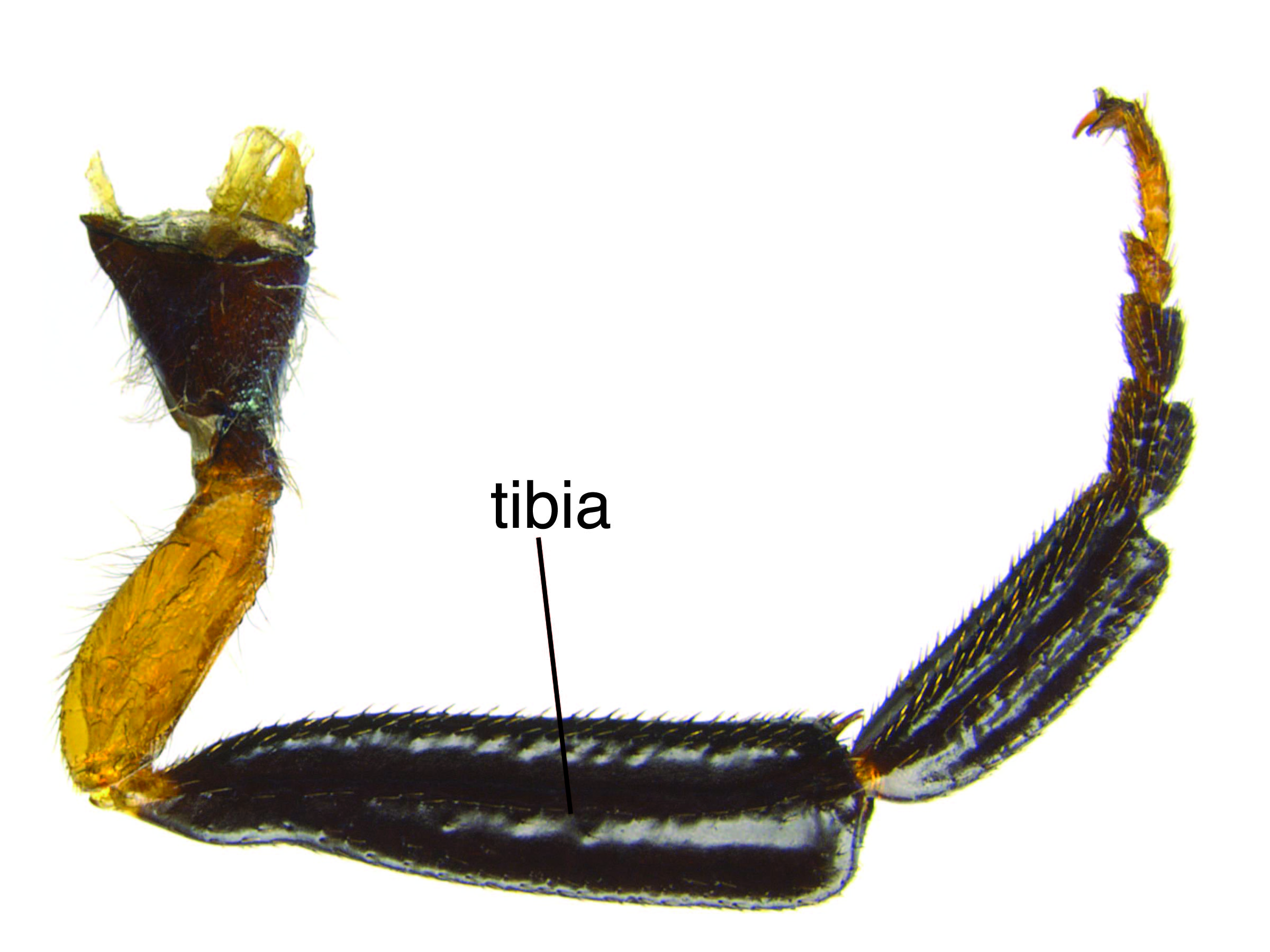Family: Argidae
Family common name: argid sawflies
Subfamily: Sterictiphorinae
Genus: Aproceros, Malaise, 1931
Subgenera: none
Argidae are found in all non-polar regions of the world (Smith and Middlekauff 1987Smith and Middlekauff 1987:
Smith DR and Middlekauff WW. 1987. Suborder Symphyta. In: Stehr FW ed. Immature Insects. Kendall/Hunt Publishing Company. Vol. 1: 754 pp., Smith 1992Smith 1992:
Smith DR. 1992. A synopsis of the sawflies (Hymenoptera: Symphyta) of America south of the United States: Argidae. Memoirs of the American Entomological Society 39: 1-201.). They are external foliage feeders with a wide range of host plants. Additionally, the family exhibits some uncommon behaviors like the excretion of defensive compounds and subsocialsubsocial:
Living in aggregations but lacking organizational structure as in true social insects; can describes insects with tendencies to protect or care for thier young, feed gregariously, and build cocoon masses.
habits (Smith 1992Smith 1992:
Smith DR. 1992. A synopsis of the sawflies (Hymenoptera: Symphyta) of America south of the United States: Argidae. Memoirs of the American Entomological Society 39: 1-201.).
Aproceros is represented in North America by a single species, which is a major forestry pest (Martel 2020Martel 2020:
Martel V. 2020. Citizen scientist spots a newcomer on Canadian elm trees. Simply Science, Natural Resources Canada. Online.). Aproceros leucopoda is black and brown with yellow and white legs and darkened wings (Blank et al. 2010aBlank et al. 2010a:
Blank SM, Hara H, Mikulaacute;s J, Csoacute;ka G, Ciornei C, Constantineanu R, Constantineanu I, Roller L, Altenhofer E, Huflejt T, and Veacute;tek G. 2010a. Aproceros leucopoda (Hymenoptera: Argidae): an East Asian pest of elms (Ulmus spp.) invading Europe. European Journal of Entomology 107(3): 357-367.).
There are 10 described species worldwide, generally restricted to Asia. Only one species is known in North America (Taeger et al. 2010Taeger et al. 2010:
Taeger A, Blank SM, and Liston AD. 2010. World Catalog of Symphyta (Hymenoptera). Zootaxa 2580: 1-1064., Blank et al. 2014Blank et al. 2014:
Blank SM, Kouml;hler T, Pfannenstill T, Neuenfeldt N, Zimmer B, Jansen E, Taeger A, and Liston AD. 2014. Zig- zagging across Central Europe: recent range extension, dispersal speed and larval hosts of Aproceros leucopoda (Hymenoptera, Argidae) in Germany. Journal of Hymenoptera Research 41: 57-74. https://doi.org/10.3897/JHR.41.8681).
 (Blank et al. 2010aBlank et al. 2010a:
(Blank et al. 2010aBlank et al. 2010a: less than width of cenchruscenchrus:
less than width of cenchruscenchrus: (Smith 1992Smith 1992:
(Smith 1992Smith 1992: fused laterally with first tergitetergite:
fused laterally with first tergitetergite: (Smith 1992Smith 1992:
(Smith 1992Smith 1992: R open at apexapex:
R open at apexapex: clavate (Blank et al. 2010aBlank et al. 2010a:
clavate (Blank et al. 2010aBlank et al. 2010a: anal cellanal cell:
anal cellanal cell: absent (Blank et al. 2010aBlank et al. 2010a:
absent (Blank et al. 2010aBlank et al. 2010a: vein M and Rs+M meeting at same point, or very close to same point, on veinvein:
vein M and Rs+M meeting at same point, or very close to same point, on veinvein: Sc+R (Blank et al. 2010aBlank et al. 2010a:
Sc+R (Blank et al. 2010aBlank et al. 2010a: white (Blank et al. 2010aBlank et al. 2010a:
white (Blank et al. 2010aBlank et al. 2010a:The family Argidae can be distinguished by the single-segmented flagellumflagellum:
the third section of the antennae that includes all the segments beyond the pedicel; segments of the flagellum are known as flagellomeres
 of the antennaantenna:
of the antennaantenna:
the sensory organ emerging from the front of the head, usually between the compound eyes and above the clypeus; includes the flagellum, scape and pedicel
 . Aproceros leucopoda females can be distinguished from Arge by the lack of preapicalpreapical:
. Aproceros leucopoda females can be distinguished from Arge by the lack of preapicalpreapical:
close to, but anterior to, the apex
 spurs on the tibiaetibia:
spurs on the tibiaetibia:
the fourth segment of the leg, between the femur and the tarsus
 , and an open cellcell:
, and an open cellcell:
1. a membranous area of the wing between veins, 2. a small cavity or closed space
 R and a lack of veinvein:
R and a lack of veinvein:
a tube-like, often darkened, structure on the wings
 Sc in the fore wingfore wing:
Sc in the fore wingfore wing:
the anterior wing of each pair of wings; usually the largest wing of the pair
 . It can be distinguished from Sphacophilus, Sterictiphora, and Aprosthema by the lack of an anal cellanal cell:
. It can be distinguished from Sphacophilus, Sterictiphora, and Aprosthema by the lack of an anal cellanal cell:
cell A of either the fore wing or hind wing
 in the hind winghind wing:
in the hind winghind wing:
the posterior wing of each pair of wings
 (Smith 1992Smith 1992:
(Smith 1992Smith 1992:
Smith DR. 1992. A synopsis of the sawflies (Hymenoptera: Symphyta) of America south of the United States: Argidae. Memoirs of the American Entomological Society 39: 1-201., Blank et al. 2010aBlank et al. 2010a:
Blank SM, Hara H, Mikulaacute;s J, Csoacute;ka G, Ciornei C, Constantineanu R, Constantineanu I, Roller L, Altenhofer E, Huflejt T, and Veacute;tek G. 2010a. Aproceros leucopoda (Hymenoptera: Argidae): an East Asian pest of elms (Ulmus spp.) invading Europe. European Journal of Entomology 107(3): 357-367.).
none
Larvae are external leaf feeders on various species species of elms. The larvaelarva:
the immature stage of holometabolous insects
 discovered in North America was found on Ulmus americana (American elm) (iNaturalist). In Europe, it is recorded on Ulmus pumila (Siberian elm), U. glabra (wych elm) and U. procera (field elm) (Blank et al. 2014Blank et al. 2014:
discovered in North America was found on Ulmus americana (American elm) (iNaturalist). In Europe, it is recorded on Ulmus pumila (Siberian elm), U. glabra (wych elm) and U. procera (field elm) (Blank et al. 2014Blank et al. 2014:
Blank SM, Kouml;hler T, Pfannenstill T, Neuenfeldt N, Zimmer B, Jansen E, Taeger A, and Liston AD. 2014. Zig- zagging across Central Europe: recent range extension, dispersal speed and larval hosts of Aproceros leucopoda (Hymenoptera, Argidae) in Germany. Journal of Hymenoptera Research 41: 57-74. https://doi.org/10.3897/JHR.41.8681).
Aproceros leucopoda is commonly known as the “elm zigzag sawfly” due to its unusual larval feeding behavior. Females deposit eggs on the margin of leaves. The hatched larvalarva:
the immature stage of holometabolous insects
 eats the leaf issue from outside edge inwards, going back and forth to create zig-zag cutouts, similar to the wider winding cutouts left by some species of Sterictiphora. As the larvaelarva:
eats the leaf issue from outside edge inwards, going back and forth to create zig-zag cutouts, similar to the wider winding cutouts left by some species of Sterictiphora. As the larvaelarva:
the immature stage of holometabolous insects
 mature, they transition to feeding on the entire leaf, sometimes leaving only the midvein. The prepupaprepupa:
mature, they transition to feeding on the entire leaf, sometimes leaving only the midvein. The prepupaprepupa:
the active, non-feeding life stage in which the larva prepares to enter the pupal stage
forms a cocoon on the underside of the remaining leaf (Doychev 2015Doychev 2015:
Doychev D. 2015. First record of the invasive elm sawfly Aproceros leucopoda Takeuchi (Hymenoptera: Argidae) in Bulgaria. Silva Balcanica 16(1): 108-112., Martel 2020Martel 2020:
Martel V. 2020. Citizen scientist spots a newcomer on Canadian elm trees. Simply Science, Natural Resources Canada. Online.). The success of A. leucopoda as a pest is credited to its short life cycle (egg to adult in less than a month), multiple generations per year, cold tolerance, and parthenogenetic:
reproductive capabilities (Martel 2020Martel 2020:
Martel V. 2020. Citizen scientist spots a newcomer on Canadian elm trees. Simply Science, Natural Resources Canada. Online., Vétek et al. 2020Vétek et al. 2020:
Vétek G, Fekete V, Ladányi M, Cargnus E, Zandigiacomo P, Oláh R, Schebeck M, and Schopf A. 2020. Cold tolerance strategy and cold hardiness of the invasive zigzag elm sawfly Aproceros leucopoda (Hymenoptera: Argidae). Agricultural and Forest Entomology 22(3): .1-7. https://doi.org/10.1111/afe.12376).
World: Aproceros is a genus native to East Asia and ranges as far east as Japan and as far south as southern China (Blank et al. 2010aBlank et al. 2010a:
Blank SM, Hara H, Mikulaacute;s J, Csoacute;ka G, Ciornei C, Constantineanu R, Constantineanu I, Roller L, Altenhofer E, Huflejt T, and Veacute;tek G. 2010a. Aproceros leucopoda (Hymenoptera: Argidae): an East Asian pest of elms (Ulmus spp.) invading Europe. European Journal of Entomology 107(3): 357-367., Taeger et al. 2010Taeger et al. 2010:
Taeger A, Blank SM, and Liston AD. 2010. World Catalog of Symphyta (Hymenoptera). Zootaxa 2580: 1-1064.). Introduction of Aproceros leucopoda was first observed in Europe in 2003 and has since been observed in Austria, Hungary, Poland, Romania, Slovakia, Ukraine, Germany, Belgium, the Netherlands, Russia, Moldova, Slovenia and Italy (Blank et al. 2010aBlank et al. 2010a:
Blank SM, Hara H, Mikulaacute;s J, Csoacute;ka G, Ciornei C, Constantineanu R, Constantineanu I, Roller L, Altenhofer E, Huflejt T, and Veacute;tek G. 2010a. Aproceros leucopoda (Hymenoptera: Argidae): an East Asian pest of elms (Ulmus spp.) invading Europe. European Journal of Entomology 107(3): 357-367., Blank et al. 2014Blank et al. 2014:
Blank SM, Kouml;hler T, Pfannenstill T, Neuenfeldt N, Zimmer B, Jansen E, Taeger A, and Liston AD. 2014. Zig- zagging across Central Europe: recent range extension, dispersal speed and larval hosts of Aproceros leucopoda (Hymenoptera, Argidae) in Germany. Journal of Hymenoptera Research 41: 57-74. https://doi.org/10.3897/JHR.41.8681).
North America: A. leucopoda is introduced in North America and was first observed in Quebec, Canada in 2020 (Martel 2020Martel 2020:
Martel V. 2020. Citizen scientist spots a newcomer on Canadian elm trees. Simply Science, Natural Resources Canada. Online.).
Map data from: GBIF.org (28 December 2020) GBIF Occurrence Download Aproceros
Details about data used for maps can be found here.